Formula One
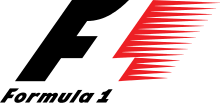 | |
| Category | Single seater |
|---|---|
| Country | International |
| Inaugural season | 1950[1] |
| Drivers | 22 |
| Constructors | 11 |
| Engine suppliers | Ferrari · Mercedes · Renault · Honda |
| Tyre suppliers | Pirelli |
| Drivers' champion |
(Mercedes AMG Petronas) |
| Constructors' champion |
|
| Official website |
www |
|
| |
| Formula One |
|---|
|
Season summaries |
|
Lists |
|
Records |
Formula One (also Formula 1 or F1 and officially the FIA Formula One World Championship) is the highest class of single-seat auto racing that is sanctioned by the Fédération Internationale de l'Automobile (FIA). The FIA Formula One World Championship has been the premier form of racing since the inaugural season in 1950, although other Formula One races were regularly held until 1983. The "formula", designated in the name, refers to a set of rules, to which all participants' cars must conform.[2] The F1 season consists of a series of races, known as Grands Prix (from French, meaning grand prizes), held worldwide on purpose-built F1 circuits and public roads.
The results of each race are evaluated using a points system to determine two annual World Championships, one for drivers, one for constructors. The racing drivers are required to be holders of valid Super Licences, the highest class of racing licence issued by the FIA.[3] The races are required to be held on tracks graded 1 (formerly A), the highest grade a track can receive by the FIA.[3] Most events are held in rural locations on purpose-built tracks, but there are several events in city centres throughout the world, with the Monaco Grand Prix being the most famous example.
Formula One cars are the fastest road course racing cars in the world, owing to very high cornering speeds achieved through the generation of large amounts of aerodynamic downforce. Formula One cars race at speeds of up to approximately 380 km/h (240 mph) with engines currently limited in performance to a maximum of 15,000 RPM. The cars are capable of lateral acceleration in excess of five g in corners. The performance of the cars is very dependent on electronics – although traction control and other driving aids have been banned since 2008 – and on aerodynamics, suspension, and tyres. The formula has radically evolved and changed through the history of the sport.
While Europe is the sport's traditional base, and hosts about half of each year's races, the sport's scope has expanded significantly and an increasing number of Grands Prix are held on other continents. F1 had a total global television audience of 425 million people during the course of the 2014 season.[4] Grand Prix racing began in 1906 and became the most popular type internationally in the second half of the twentieth century. The Formula One Group is the legal holder of the commercial rights.[5]
With the cost of designing and building mid-tier cars being of the order of $120 million,[6] Formula One's economic effect and creation of jobs are significant, and its financial and political battles are widely reported. Its high profile and popularity have created a major merchandising environment, which has resulted in great investments from sponsors and budgets in the hundreds of millions for the constructors. Since 2000 the sport's spiraling expenditures and the distribution of prize money favoring established top teams have forced complaints from smaller teams and led several teams to bankruptcy.
On 8 September 2016 it was announced that Liberty Media Corp. had agreed to buy Delta Topco, the company that controls Formula One, from private equity firm CVC Capital Partners for $4.4 billion in cash, stock and convertible debt.[7]
History
The Formula One series originated with the European Grand Prix Motor Racing (q.v. for pre-1947 history) of the 1920s and 1930s. The formula is a set of rules that all participants' cars must meet. Formula One was a new formula agreed upon after World War II during 1946, with the first non-championship races being held that year. A number of Grand Prix racing organisations had laid out rules for a world championship before the war, but due to the suspension of racing during the conflict, the World Drivers' Championship was not formalised until 1947. The first world championship race was held at Silverstone, United Kingdom in 1950. A championship for constructors followed in 1958. National championships existed in South Africa and the UK in the 1960s and 1970s. Non-championship Formula One events were held for many years, but due to the increasing cost of competition, the last of these occurred in 1983.[8]
Return of racing
.jpg)
The first World Championship for Drivers was won by Italian Giuseppe Farina in his Alfa Romeo in 1950, barely defeating his Argentine teammate Juan Manuel Fangio. However, Fangio won the title in 1951, 1954, 1955, 1956, and 1957 (His record of five World Championship titles stood for 45 years until German driver Michael Schumacher took his sixth title in 2003), his streak interrupted (after an injury) by two-time champion Alberto Ascari of Ferrari. Although the UK's Stirling Moss was able to compete regularly, he was never able to win the world championship, and is now widely considered to be the greatest driver never to have won the title.[9][10] Fangio, however, is remembered for dominating Formula One's first decade and has long been considered the "Grand Master" of Formula One.
This period featured teams managed by road car manufacturers Alfa Romeo, Ferrari, Mercedes-Benz, and Maserati; all of whom had competed before the war. The first seasons were run using pre-war cars like Alfa's 158. They were front-engined, with narrow tyres and 1.5-litre supercharged or 4.5-litre normally aspirated engines. The 1952 and 1953 world championships were run to Formula Two regulations, for smaller, less powerful cars, due to concerns over the paucity of Formula One cars available.[11] When a new Formula One, for engines limited to 2.5 litres, was reinstated to the world championship for 1954, Mercedes-Benz introduced the advanced W196, which featured innovations such as desmodromic valves and fuel injection as well as enclosed streamlined bodywork. Mercedes drivers won the championship for two years, before the team withdrew from all motorsport in the wake of the 1955 Le Mans disaster.[12]
The Garagistes
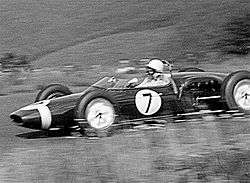
The first major technological development, Bugatti's re-introduction of mid-engined cars (following Ferdinand Porsche's pioneering Auto Unions of the 1930s), occurred with the Type 251, which was unsuccessful. Australian Jack Brabham, world champion during 1959, 1960, and 1966, soon proved the mid-engined design's superiority. By 1961, all regular competitors had switched to mid-engined cars. The Ferguson P99, a four-wheel drive design, was the last front-engined F1 car to enter a world championship race. It was entered in the 1961 British Grand Prix, the only front-engined car to compete that year.[13]
The first British World Champion was Mike Hawthorn, who drove a Ferrari to the title during the 1958 season. However, when Colin Chapman entered F1 as a chassis designer and later founder of Team Lotus, British racing green came to dominate the field for the next decade. Including Brabham, Jim Clark, Jackie Stewart, John Surtees, Graham Hill, and Denny Hulme, British teams and Commonwealth drivers won twelve world championships between 1962 and 1973.
During 1962, Lotus introduced a car with an aluminium-sheet monocoque chassis instead of the traditional space-frame design. This proved to be the greatest technological breakthrough since the introduction of mid-engined cars. During 1968, Lotus painted Imperial Tobacco livery on their cars, thus introducing sponsorship to the sport.[14][15]
Aerodynamic downforce slowly gained importance in car design from the appearance of aerofoils during the late 1960s. During the late 1970s, Lotus introduced ground-effect aerodynamics (previously used on Jim Hall's Chaparral 2J during 1970) that provided enormous downforce and greatly increased cornering speeds. So great were the aerodynamic forces pressing the cars to the track (up to five times the car's weight), extremely stiff springs were needed to maintain a constant ride height, leaving the suspension virtually solid, depending entirely on the tyres for any small amount of cushioning of the car and driver from irregularities of the road surface.[16]
Big business

Beginning in the 1970s, Bernie Ecclestone rearranged the management of Formula One's commercial rights; he is widely credited with transforming the sport into the multibillion-dollar business it now is.[17][18] When Ecclestone bought the Brabham team during 1971 he gained a seat on the Formula One Constructors' Association and during 1978 he became its president. Previously, the circuit owners controlled the income of the teams and negotiated with each individually, however Ecclestone persuaded the teams to "hunt as a pack" through FOCA.[18] He offered Formula One to circuit owners as a package, which they could take or leave. In return for the package almost all that was required was to surrender trackside advertising.[17]
The formation of the Fédération Internationale du Sport Automobile (FISA) during 1979 set off the FISA–FOCA controversy, during which FISA and its president Jean-Marie Balestre disputed repeatedly with FOCA over television revenues and technical regulations.[19] The Guardian said of FOCA that Ecclestone and Max Mosley "used it to wage a guerrilla war with a very long-term aim in view". FOCA threatened to establish a rival series, boycotted a Grand Prix and FISA withdrew its sanction from races.[17] The result was the 1981 Concorde Agreement, which guaranteed technical stability, as teams were to be given reasonable notice of new regulations.[20] Although FISA asserted its right to the TV revenues, it handed the administration of those rights to FOCA.[21]
FISA imposed a ban on ground-effect aerodynamics during 1983.[22] By then, however, turbocharged engines, which Renault had pioneered in 1977, were producing over 700 bhp (520 kW) and were essential to be competitive. By 1986, a BMW turbocharged engine achieved a flash reading of 5.5 bar pressure, estimated to be over 1,300 bhp (970 kW) in qualifying for the Italian Grand Prix. The next year power in race trim reached around 1,100 bhp (820 kW), with boost pressure limited to only 4.0 bar.[23] These cars were the most powerful open-wheel circuit racing cars ever. To reduce engine power output and thus speeds, the FIA limited fuel tank capacity in 1984 and boost pressures in 1988 before banning turbocharged engines completely in 1989.[24]
The development of electronic driver aids began during the 1980s. Lotus began to develop a system of active suspension, which first appeared during 1982 on the 91. By 1987, this system had been perfected and was driven to victory by Ayrton Senna in the Monaco Grand Prix that year. In the early 1990s other teams followed suit and semi-automatic gearboxes and traction control were a natural progression. The FIA, due to complaints that technology was determining the outcome of races more than driver skill, banned many such aids for 1994. This resulted in cars that were previously dependent on electronic aids becoming very "twitchy" and difficult to drive (particularly the Williams FW16). Many observers felt the ban on driver aids was in name only as they "proved difficult to police effectively".[25]
The teams signed a second Concorde Agreement during 1992 and a third in 1997, which expired on the last day of 2007.[26]
On the track, the McLaren and Williams teams dominated the 1980s and 1990s, with Brabham also being competitive during the early part of the 1980s, winning two Drivers' Championships with Nelson Piquet. Powered by Porsche, Honda, and Mercedes-Benz, McLaren won sixteen championships (seven constructors' and nine drivers') in that period, while Williams used engines from Ford, Honda, and Renault to also win sixteen titles (nine constructors' and seven drivers'). The rivalry between racers Ayrton Senna and Alain Prost became F1's central focus during 1988, and continued until Prost retired at the end of 1993. Senna died at the 1994 San Marino Grand Prix after crashing into a wall on the exit of the notorious curve Tamburello, having taken over Prost's lead drive at Williams that year. The FIA worked to improve the sport's safety standards since that weekend, during which Roland Ratzenberger also lost his life in an accident during Saturday qualifying. No driver had died of injuries sustained on the track at the wheel of a Formula One car for 20 years, until the 2014 Japanese Grand Prix where Jules Bianchi collided with a recovery vehicle after aquaplaning off the circuit. Since 1994, three track marshals have lost their lives, one at the 2000 Italian Grand Prix,[27] the second at the 2001 Australian Grand Prix[27] and the third at the 2013 Canadian Grand Prix.
Since the deaths of Senna and Ratzenberger, the FIA has used safety as a reason to impose rule changes that otherwise, under the Concorde Agreement, would have had to be agreed upon by all the teams — most notably the changes introduced for 1998. This so-called 'narrow track' era resulted in cars with smaller rear tyres, a narrower track overall, and the introduction of grooved tyres to reduce mechanical grip. There were to be four grooves on the front (three in the first year) and rear that ran through the entire circumference of the tyre. The objective was to reduce cornering speeds and to produce racing similar to rainy conditions by enforcing a smaller contact patch between tyre and track. This, according to the FIA, was to promote driver skill and provide a better spectacle.
Results have been mixed as the lack of mechanical grip has resulted in the more ingenious designers clawing back the deficit with aerodynamic grip — pushing more force onto the tyres through wings and aerodynamic devices, which in turn has resulted in less overtaking as these devices tend to make the wake behind the car 'dirty' (turbulent), preventing other cars from following closely due to their dependence on 'clean' air to make the car stick to the track. The grooved tyres also had the unfortunate side effect of initially being of a harder compound to be able to hold the grooved tread blocks, which resulted in spectacular accidents in times of aerodynamic grip failure as the harder compound could not grip the track as well.
Drivers from McLaren, Williams, Renault (formerly Benetton), and Ferrari, dubbed the "Big Four", won every World Championship from 1984 to 2008 and the teams themselves won every Constructors' Championship from 1979 to 2008. Due to the technological advances of the 1990s, the cost of competing in Formula One increased dramatically. This increased financial burdens, combined with the dominance of four teams (largely funded by big car manufacturers such as Mercedes-Benz), caused the poorer independent teams to struggle not only to remain competitive, but to stay in business, and forced several teams to withdraw. Since 1990, twenty-eight teams have withdrawn from Formula One. This has prompted former Jordan owner Eddie Jordan to say that the days of competitive privateers are over.[28]
Manufacturers' return
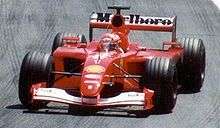
Michael Schumacher and Ferrari won five consecutive Drivers' Championships (2000–2004) and six consecutive constructors' championships (1999–2004). Schumacher set many new records, including those for Grand Prix wins (91), wins in a season (thirteen of eighteen), and most Drivers' Championships (seven).[29] Schumacher's championship streak ended on 25 September 2005 when Renault driver Fernando Alonso became Formula One's youngest champion at that time, until Sebastian Vettel in 2010. During 2006, Renault and Alonso won both titles again. Schumacher retired at the end of 2006 after sixteen years in Formula One, but came out of retirement for the 2010 season, racing for the newly formed Mercedes works team, following the rebrand of Brawn GP.
During this period, the championship rules were changed frequently by the FIA with the intention of improving the on-track action and cutting costs.[30] Team orders, legal since the championship started during 1950, were banned during 2002 after several incidents in which teams openly manipulated race results, generating negative publicity, most famously by Ferrari at the 2002 Austrian Grand Prix. Other changes included the qualifying format, the points scoring system, the technical regulations, and rules specifying how long engines and tyres must last. A "tyre war" between suppliers Michelin and Bridgestone saw lap times fall, although at the 2005 United States Grand Prix at Indianapolis, seven out of ten teams did not race when their Michelin tyres were deemed unsafe for use, leading to Bridgestone becoming the sole tyre supplier to Formula One for the 2007 season. During 2006, Max Mosley outlined a "green" future for Formula One, in which efficient use of energy would become an important factor.[31]
Since 1983, Formula One had been dominated by specialist race teams like Williams, McLaren, and Benetton, using engines supplied by large car manufacturers like Mercedes-Benz, Honda, Renault, and Ford. Starting in 2000, with Ford's creation of the largely unsuccessful Jaguar team, new manufacturer-owned teams entered Formula One for the first time since the departure of Alfa Romeo and Renault at the end of 1985. By 2006, the manufacturer teams–Renault, BMW, Toyota, Honda, and Ferrari–dominated the championship, taking five of the first six places in the constructors' championship. The sole exception was McLaren, which at the time was part-owned by Mercedes Benz. Through the Grand Prix Manufacturers Association (GPMA), they negotiated a larger share of Formula One's commercial profit and a greater say in the running of the sport.
Manufacturers' decline and return of the privateers
In 2008 and 2009, Honda, BMW, and Toyota all withdrew from Formula One racing within the space of a year, blaming the economic recession. This resulted in the end of manufacturer dominance within the sport. The Honda F1 team went through a management buyout to become Brawn GP with the notable F1 designer Ross Brawn and Nick Fry running and owning the majority of the organisation. Brawn GP went through a painful size reduction, laying off hundreds of employees, but eventually won the year's world championships with Jenson Button and Rubens Barrichello. BMW F1 was bought out by the original founder of the team, Peter Sauber. The Lotus F1 Team[32] are another, formerly manufacturer-owned team that has reverted to "privateer" ownership, together with the buy-out of the Renault F1 Team by Genii Capital investors in recent years. A link with their previous owners still survived however, with their car continuing to be powered by a Renault Power Unit until 2014.

McLaren also announced that it was to reacquire the shares in its team from Mercedes Benz (McLaren's partnership with Mercedes was reported to have started to sour with the McLaren Mercedes SLR road car project and tough F1 championships which included McLaren being found guilty of spying on Ferrari). Hence, during the 2010 season, Mercedes Benz re-entered the sport as a manufacturer after its purchase of Brawn GP, and split with McLaren after 15 seasons with the team. This leaves Mercedes, McLaren, and Ferrari as the only car manufacturers in the sport, although both McLaren and Ferrari began as racing teams rather than manufacturers.
AT&T Williams confirmed towards the end of 2009 their new engine deal with Cosworth, who also supplied the wave of new teams Virgin Racing, Hispania Racing F1, and the newly formed Lotus Racing team. The exit of car manufacturers has also paved the way for teams representing their countries, with some having the funding by their respective national governments (such as Lotus being funded by Malaysia, Lotus Cars being owned by Proton, a Malaysian manufacturer, and Lotus Racing being run by Tony Fernandes, a Malaysian business man known for his Asian low-cost airline). Williams later rejoined with Renault in 2012, rekindling a partnership that dates back to the early to mid-1990s. However, the partnership was short lived and as of the 2014 F1 season, Williams competes with the Mercedes Power Unit.
A rule shake-up in 2014 meant Mercedes emerged as the dominant force, with Lewis Hamilton winning the championship closely followed by his main rival and team-mate, Nico Rosberg, with the team winning 16 out of the 19 races that season (all other victories coming from Daniel Ricciardo of Red Bull). 2014 also saw a financial crisis which resulted in the backmarker Marussia and Caterham teams being put into administration, alongside the uncertain futures of Force India and Sauber. Marussia returned under the Manor name in 2015, a season in which Ferrari were the only challengers to Mercedes, with Vettel taking victory in the three Grands Prix Mercedes did not win.[33] The 2016 season began in dominant fashion for Nico Rosberg, winning the first 4 Grands Prix. His charge was halted by Max Verstappen, who took his maiden win in Spain in his debut race for Red Bull. After his charge halting, the reigning champion Lewis Hamilton decreased the point gap between them to only one point.
Political disputes
FISA–FOCA war
The battle for control of Formula One was contested between the Fédération Internationale du Sport Automobile (FISA), at the time an autonomous subcommittee of the FIA, and FOCA (the Formula One Constructors' Association).
The beginnings of the dispute are numerous, and many of the underlying reasons may be lost in history. The teams (excepting Ferrari and the other major manufacturers – Renault and Alfa Romeo in particular) were of the opinion that their rights and ability to compete against the larger and better funded teams were being negatively affected by a perceived bias on the part of the controlling organisation (FISA) toward the major manufacturers.
In addition, the battle revolved around the commercial aspects of the sport (the FOCA teams were unhappy with the disbursement of proceeds from the races) and the technical regulations which, in FOCA's opinion, tended to be malleable according to the nature of the transgressor more than the nature of the transgression.
The war culminated in a FOCA boycott of the 1982 San Marino Grand Prix months later. In theory, all FOCA teams were supposed to boycott the Grand Prix as a sign of solidarity and complaint at the handling of the regulations and financial compensation (and extreme opposition to the accession of Balestre to the position of FISA president: both Colin Chapman of Lotus and Frank Williams of Williams stated clearly that they would not continue in Formula One with Balestre as its governor). In practice, several of the FOCA teams backed out of the boycott, citing "sponsor obligations". Notable among these were the Tyrrell and Toleman teams.
FIA–FOTA dispute
During the 2009 season of Formula One, the sport was gripped in a governance crisis. The FIA President Max Mosley proposed numerous cost cutting measures for the following season, including an optional budget cap for the teams;[34] teams electing to take the budget cap would be granted greater technical freedom, adjustable front and rear wings and an engine not subject to a rev limiter.[34] The Formula One Teams Association (FOTA) believed that allowing some teams to have such technical freedom would have created a 'two-tier' championship, and thus requested urgent talks with the FIA. However, talks broke down and FOTA teams announced, with the exception of Williams and Force India,[35][36] that 'they had no choice' but to form a breakaway championship series.[36]

On 24 June, an agreement was reached between Formula One's governing body and the teams to prevent a breakaway series. It was agreed teams must cut spending to the level of the early 1990s within two years; exact figures were not specified,[37] and Max Mosley agreed he would not stand for re-election to the FIA presidency in October.[38] Following further disagreements after Max Mosley suggested he would stand for re-election,[39] FOTA made it clear that breakaway plans were still being pursued. On 8 July, FOTA issued a press release stating they had been informed they were not entered for the 2010 season,[40] and an FIA press release said the FOTA representatives had walked out of the meeting.[41] On 1 August, it was announced FIA and FOTA had signed a new Concorde Agreement, bringing an end to the crisis and securing the sport's future until 2012.[42]
Outside the World Championship
The terms "Formula One race" and "World Championship race" are effectively synonymous; since 1984, every Formula One race has counted towards an official FIA World Championship, and every World Championship race has been held to Formula One regulations.[43] In the earlier history of Formula One, many races took place outside the world championship, and local championships run to Formula One regulations also occurred. These events often took place on circuits that were not suitable for the World Championship, and featured local cars and drivers as well as those competing in the Championship.[8]
European non-championship racing
In the early years of Formula One, before the world championship was established, there were around twenty races held from late Spring to early Autumn in Europe, although not all of these were considered significant. Most competitive cars came from Italy, particularly Alfa Romeo. After the start of the world championship, these non-championship races continued. In the 1950s and 1960s, there were many Formula One races which did not count for the World Championship; in 1950 a total of twenty-two Formula One races were held, of which only six counted towards the World Championship.[43] In 1952 and 1953, when the world championship was run for Formula Two cars, non-championship events were the only Formula One races that took place.
Some races, particularly in the UK, including the Race of Champions, Oulton Park International Gold Cup and the International Trophy, were attended by the majority of the world championship contenders. Other smaller events were regularly held in locations not part of the championship, such as the Syracuse and Danish Grands Prix, although these only attracted a small amount of the championship teams and relied on private entries and lower Formula cars to make up the grid.[8] These became less common through the 1970s and 1983 saw the last non-championship Formula One race; the 1983 Race of Champions at Brands Hatch, won by reigning World Champion Keke Rosberg in a Williams-Cosworth in a close fight with American Danny Sullivan.[8]
South African Formula One championship
South Africa's flourishing domestic Formula One championship ran from 1960 through to 1975. The frontrunning cars in the series were recently retired from the world championship although there was also a healthy selection of locally built or modified machines. Frontrunning drivers from the series usually contested their local World Championship Grand Prix, as well as occasional European events, although they had little success at that level.
British Formula One Series
The DFV helped make the UK domestic Formula One series possible between 1978 and 1980. As in South Africa a decade before, second hand cars from manufacturers like Lotus and Fittipaldi Automotive were the order of the day, although some, such as the March 781, were built specifically for the series. In 1980, the series saw South African Desiré Wilson become the only woman to win a Formula One race when she triumphed at Brands Hatch in a Wolf WR3.[44]
Racing and strategy
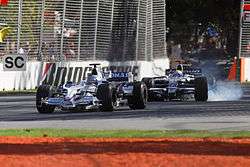
A Formula One Grand Prix event spans a weekend. It begins with two free practice sessions on Friday (except in Monaco, where Friday practices are moved to Thursday), and one free practice on Saturday. Additional drivers (commonly known as third drivers) are allowed to run on Fridays, but only two cars may be used per team, requiring a race driver to give up his seat. A qualifying session is held after the last free practice session. This session determines the starting order for the race on Sunday.[45][46]
Qualifying

For much of the sport's history, qualifying sessions differed little from practice sessions; drivers would have one or more sessions in which to set their fastest time, with the grid order determined by each driver's best single lap, with the fastest on pole position. Grids were generally limited to 26 cars – if the race had more entries, qualification would also decide which drivers would start the race. During the early 1990s, the number of entries was so high that the worst-performing teams had to enter a pre-qualifying session, with the fastest cars allowed through to the main qualifying session. The qualifying format began to change in the late 1990s, with the FIA experimenting with limiting the number of laps, determining the aggregate time over two sessions, and allowing each driver only one qualifying lap.
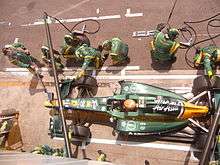
The current qualifying system was adopted in the 2006 season. Known as "knock-out" qualifying, it is split into three periods, known as Q1, Q2, and Q3. In each period, drivers run qualifying laps to attempt to advance to the next period, with the slowest drivers being "knocked out" at the end of the period and their grid positions set, based on their best lap times. Drivers are allowed as many laps as they wish within each period. After each period, all times are reset, and only a driver's fastest lap in that period (barring infractions) counts. Any timed lap started before the end of that period may be completed, and will count toward that driver's placement. The number of cars eliminated in each period is dependent on the total number of cars entered into the championship.[47] Currently, with 22 cars, Q1 runs for 18 minutes, and eliminates the slowest six drivers. During this period, any driver whose best lap time exceeds 107% of the fastest time in Q1, will not be allowed to start the race without permission from the stewards. This rule does not affect drivers in Q2 or Q3. In Q2, the 16 remaining drivers have 15 minutes to set one of the ten fastest times and proceed to the next period. Finally, Q3 lasts 12 minutes and sees the remaining ten drivers decide the first ten grid positions. At the beginning of the 2016 Formula 1 season, the FIA introduced a new qualifying format, whereby drivers were knocked out every 90 seconds after a certain amount of time had passed in each session. The aim was to mix up grid positions for the race, but due to unpopularity the FIA reverted to the above qualifying format for the Chinese GP, after running the format for only two races.[47]
Drivers may run any of the three available tyre compounds throughout the qualifying session. As of the 2016 season there are three tyre compounds available every race. This had to do with Pirelli's introduction of the new ultrasoft compound.[48] In prior seasons only two compounds were available per race, the "prime" and the "option" compound. Each car taking part in the final period receives an extra set of the softest available tyre. The first ten drivers on ten must start the race on the tyre which set the fastest time in Q2, unless the weather requires the use of wet-weather tyres.[49] Any penalties that affect grid position are applied at the end of qualifying. Grid penalties can be applied for driving infractions in the previous or current Grand Prix, or for changing a gearbox or engine component. If a car fails scrutineering, the driver will be excluded from qualifying, but will be allowed to start the race from the back of the grid at the race steward's discretion.
Race
The race begins with a warm-up lap, after which the cars assemble on the starting grid in the order they qualified. This lap is often referred to as the formation lap, as the cars lap in formation with no overtaking (although a driver who makes a mistake may regain lost ground provided he has not fallen to the back of the field). The warm-up lap allows drivers to check the condition of the track and their car, gives the tyres a chance to warm up to increase traction, and also gives the pit crews time to clear themselves and their equipment from the grid.
_qualifying_at_US_Grand_Prix_2005.jpg)
Once all the cars have formed on the grid, a light system above the track indicates the start of the race: five red lights are illuminated at intervals of one second; they are all then extinguished simultaneously after an unspecified time (typically less than 3 seconds) to signal the start of the race. The start procedure may be abandoned if a driver stalls on the grid, signalled by raising his arm. If this happens, the procedure restarts: a new formation lap begins with the offending car removed from the grid. The race may also be restarted in the event of a serious accident or dangerous conditions, with the original start voided. The race may be started from behind the Safety Car if officials feel a racing start would be excessively dangerous, such as extremely heavy rainfall. There is no formation lap when races start behind the Safety Car.[50]
Under normal circumstances, the winner of the race is the first driver to cross the finish line having completed a set number of laps, which, added together, should give a distance of approximately 305 km (190 mi) [260 km (160 mi) for Monaco]. Race officials may end the race early (putting out a red flag) due to unsafe conditions such as extreme rainfall, and it must finish within two hours, although races are only likely to last this long in the case of extreme weather or if the safety car is deployed during the race. Drivers may overtake one another for position over the course of the race and are "Classified" in the order they finished 90% of the race distance. If a leader comes across a back marker (slower car) who has completed fewer laps, the back marker is shown a blue flag[51] telling him he is obliged to allow the leader to overtake him. The slower car is said to be "lapped" and, once the leader finishes the race, is classified as finishing the race "one lap down". A driver can be lapped numerous times, by any car in front of him. A driver who fails to finish a race, through mechanical problems, accident, or any other reason is said to have retired from the race and is "Not Classified" in the results. However, if the driver has completed more than 90% of the race distance, he will be classified.

Throughout the race, drivers may make pit stops to change tyres and repair damage (from 1994 to 2009 inclusive, they could also refuel). Different teams and drivers employ different pit stop strategies in order to maximise their car's potential. Three dry tyre compounds, with different durability and adhesion characteristics, are available to drivers. Over the course of a race, drivers must use two of the three available compounds. The different compounds have different levels of performance, and choosing when to use which compound is a key tactical decision to make. Different tyres have different colours on their sidewalls; this allows spectators to understand the strategies. Under wet conditions, drivers may switch to one of two specialised wet weather tyres with additional grooves (one "intermediate", for mild wet conditions, such as after recent rain, one "full wet", for racing in or immediately after rain). A driver must make at least one stop to use two tyre compounds; up to three stops are typically made, although further stops may be necessary to fix damage or if weather conditions change. If rain tyres are used, drivers are no longer obliged to use both types of dry tyres.
- Race director
- As of 2014, the race director in Formula One is Charlie Whiting. This role involves him generally managing the logistics of each F1 Grand Prix, inspecting cars in parc fermé before a race, enforcing FIA rules and controlling the lights which start each race. As the head of the race officials, he also plays a large role in sorting disputes amongst teams and drivers. Penalties, such as drive-through penalties (and stop-and-go penalties), demotions on a pre-race start grid, race disqualifications, and fines can all be handed out should parties break regulations.
- Safety car
- In the event of an incident that risks the safety of competitors or trackside race marshals, race officials may choose to deploy the safety car. This in effect suspends the race, with drivers following the safety car around the track at its speed in race order, with overtaking not permitted. The safety car circulates until the danger is cleared; after it comes in, the race restarts with a "rolling start". Pit stops are permitted under the safety car. Mercedes-Benz supplies Mercedes-AMG models to Formula One to use as the safety cars. Since 2000,[52] the main safety car driver has been German ex-racing driver Bernd Mayländer. On the lap in which the safety car returns to the pits, the leading car takes over the role of the safety car until the first safety car line, which is usually a white line after the pit lane entrance. After crossing this line, drivers are allowed to start racing for track position once more.
- Red flag
- In the event of a major incident or unsafe weather conditions, the race may be red-flagged. Then:
- If under 3 laps have been completed when the red flag is displayed, the race is restarted from original grid positions. All drivers may restart, provided their car is in a fit state to do so.
- If between 3 laps and 75% of the race distance have been completed, the race may be restarted once it is safe to do so, maintaining the race order at the time of the red flag. The two-hour time limit still applies, however, the clock stops when the race is suspended and restarts when it resumes.
- If more than 75% of the race distance has been completed, the race is often (but not always) terminated and the race result counted back to the second last completed lap before the red flag.
- Note that the total length of the race, including any red-flag delays, cannot exceed 4 hours;[53] this rule was implemented for the 2012 Formula One season, after the 2011 Canadian Grand Prix lasted over 4 hours, caused by a rain delay of over 2 hours.[54]
The format of the race has changed little through Formula One's history. The main changes have revolved around what is allowed at pit stops. In the early days of Grand Prix racing, a driver would be allowed to continue a race in his teammate's car should his develop a problem—in the modern era, cars are so carefully fitted to drivers that this has become impossible. In recent years, the emphasis has been on changing refuelling and tyre change regulations. From the 2010 season, refuelling—which was reintroduced in 1994—has not been allowed, to encourage less tactical racing following safety concerns. The rule requiring both compounds of tyre to be used during the race was introduced in 2007, again to encourage racing on the track. The safety car is another relatively recent innovation that reduced the need to deploy the red flag, allowing races to be completed on time for a growing international live television audience.
Points system
| Position | Points |
|---|---|
| 1st | 25 |
| 2nd | 18 |
| 3rd | 15 |
| 4th | 12 |
| 5th | 10 |
| 6th | 8 |
| 7th | 6 |
| 8th | 4 |
| 9th | 2 |
| 10th | 1 |
Various systems for awarding championship points have been used since 1950. The current system, in place since 2010, awards the top ten cars points in the Drivers and Constructors Championships, with the winner receiving 25 points. If both a team's cars finish in the points, they both receive Constructors Championship points. The total number of points won at each race are added up, and the driver and constructor with the most points at the end of the season are World Champions. A driver can switch teams during the season and, for the Drivers Championship, keep all points gained at the previous team.[55]
A driver must be classified to receive points. In order to be classified, a driver need not finish the race, but complete at least 90% of the winner's race distance. Therefore, it is possible for a driver to receive points even if they retired before the end of the race.[56]
In the event that less than 75% of the race laps are completed by the winner, only half of the points listed in the table are awarded to the drivers and constructors. This has happened on only five occasions in the history of the championship, and it had a notable influence on the final standing of the 1984 season. The last occurrence was at the 2009 Malaysian Grand Prix when the race was called off after 31 laps due to torrential rain.[57]
Constructors
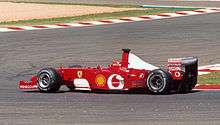
Since 1981,[58] Formula One teams have been required to build the chassis in which they compete, and consequently the terms "team" and "constructor" became more or less interchangeable. This requirement distinguishes the sport from series such as the IndyCar Series which allows teams to purchase chassis, and "spec series" such as GP2, which require all cars be kept to an identical specification. It also effectively prohibits privateers, which were common even in Formula One well into the 1970s.
The sport's debut season, 1950, saw eighteen teams compete, but due to high costs many dropped out quickly. In fact, such was the scarcity of competitive cars for much of the first decade of Formula One that Formula Two cars were admitted to fill the grids. Ferrari is the oldest Formula One team, the only still-active team which competed in 1950.
Early manufacturer involvement came in the form of a "factory team" or "works team" (that is, one owned and staffed by a major car company), such as those of Alfa Romeo, Ferrari, or Renault. After having virtually disappeared by the early 1980s, factory teams made a comeback in the 1990s and 2000s and formed up to half the grid with Ferrari, Jaguar, BMW, Renault, Toyota, and Honda either setting up their own teams or buying out existing ones. Mercedes-Benz owned 40% of the McLaren team and manufactures the team's engines. Factory teams make up the top competitive teams; in 2008 wholly owned factory teams took four of the top five positions in the Constructors' Championship, and McLaren the other. Ferrari holds the record for having won the most Constructors' Championships (sixteen). However, by the end of the 2000s factory teams were once again on the decline with only Ferrari, Mercedes-Benz and Renault lodging entries to the 2010 championship.
Companies such as Climax, Repco, Cosworth, Hart, Judd and Supertec, which had no direct team affiliation, often sold engines to teams that could not afford to manufacture them. In the early years, independently owned Formula One teams sometimes also built their engines, though this became less common with the increased involvement of major car manufacturers such as BMW, Ferrari, Honda, Mercedes-Benz, Renault, and Toyota, whose large budgets rendered privately built engines less competitive. Cosworth was the last independent engine supplier. Beginning in 2007, the manufacturers' deep pockets and engineering ability took over, eliminating the last of the independent engine manufacturers.[59] It is estimated the major teams spend between €100 and €200 million ($125–$225 million) per year per manufacturer on engines alone.[60]
In the 2007 season, for the first time since the 1981 rule, two teams used chassis built by other teams. Super Aguri started the season using a modified Honda Racing RA106 chassis (used by Honda the previous year), while Scuderia Toro Rosso used the same chassis used by the parent Red Bull Racing team, which was formally designed by a separate subsidiary. The usage of these loopholes was ended for 2010 with the publication of new technical regulations, which require each constructor to own the intellectual property rights to their chassis,[61] which prevents a team using a chassis owned by another Formula One constructor.[62] The regulations continue to allow a team to subcontract the design and construction of the chassis to a third-party, an option used by the HRT team in 2010.
Although teams rarely disclose information about their budgets, it is estimated they range from US$66 million to US$400 million each.[63]
Entering a new team in the Formula One World Championship requires a £25 million (about US$47 million) up-front payment to the FIA, which is then repaid to the team over the course of the season. As a consequence, constructors desiring to enter Formula One often prefer to buy an existing team: B.A.R.'s purchase of Tyrrell and Midland's purchase of Jordan allowed both of these teams to sidestep the large deposit and secure the benefits the team already had, such as TV revenue.
Drivers
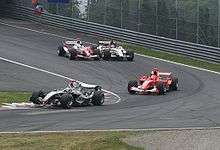
Every team in Formula One must run two cars in every session in a Grand Prix weekend, and every team may use up to four drivers in a season.[46] A team may also run two additional drivers in Free Practice sessions,[46] which are often used to test potential new drivers for a career as a Formula One driver or gain experienced drivers to evaluate the car.[64][65] Most modern drivers are contracted for at least the duration of a season, with driver changes taking place in between seasons, in comparison to early years where drivers often competed at an ad hoc basis from race to race. Each competitor must be in the possession of a FIA Super Licence to compete in a Grand Prix,[66] which is issued to drivers who have met the criteria of success in junior motorsport categories and having achieved 300 kilometres (190 mi) of running in a Formula One car. Drivers may also be issued a Super Licence by the World Motor Sport Council if they fail to meet the criteria.[66] Teams also contract test and reserve drivers, to stand in for regular drivers when necessary and develop the team's car; although with the reduction on testing the reserve drivers' role mainly takes places on a simulator,[67] such as rFactor Pro,[68][69] which is used by most of the F1 teams.[70][71] Although most drivers earn their seat on ability, commercial considerations also come into play with teams having to satisfy sponsors and financial demands.
Each driver chooses an unassigned number from 2–99 (excluding 17)[72] upon entering Formula One, and keeps that number during their time in the series. The number one is reserved for the reigning driver's champion, who retains their previous number and may choose to use it instead of the number one.[73] At the onset of the championship, numbers were allocated by race organisers on an ad-hoc basis from race to race, and competitors did not have a permanent number throughout the season.[74] Permanent numbers were introduced in 1973, when teams were allocated numbers in ascending order based upon the constructors standings. The teams would hold those numbers from season to season with the exception of the team with the world drivers champion, which would swap its numbers with the one and two of the previous champion's team. New entrants were allocated spare numbers, with the exception of the number 13 which had been unused since 1976.[75] As teams kept their numbers for long periods of time car numbers became associated with a team, such as Ferrari's 27 and 28.[74] A different system was used from 1996 to 2013. At the start of each season, the current drivers champion was designated number one, his team-mate number two, and the rest of the teams assigned ascending numbers according to previous season's constructors' championship order.[76]
A total of 33 separate drivers have won the world championship, with Michael Schumacher holding the record for most championships with seven, as well as holding the race wins and pole position records. Juan Manuel Fangio has won the next most, with five championships won during the 1950s, as well as having won the greatest percentage of wins, with 24 out of 52 entries. Jochen Rindt is the only posthumous World Champion, after his points total was not overhauled despite his fatal accident at the 1970 Italian Grand Prix. Drivers from the United Kingdom have been the most successful in the sport, with 14 championships from 10 drivers, and 214 wins from 19.
Feeder series
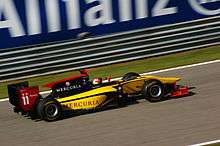
Most F1 drivers start in kart racing competitions, and then come up through traditional European single seater series like Formula Ford and Formula Renault to Formula 3, and finally the GP2 Series. GP2 started in 2005, replacing Formula 3000, which itself had replaced Formula Two as the last major stepping-stone into F1. Most champions from this level graduate into F1, but 2006 GP2 champion Lewis Hamilton became the first F2, F3000 or GP2 champion to win the Formula One driver's title in 2008.[77] Drivers are not required to have competed at this level before entering Formula One. British F3 has supplied many F1 drivers, with champions including Nigel Mansell, Ayrton Senna and Mika Häkkinen having moved straight from that series to Formula One. More rarely a driver may be picked from an even lower level, as was the case with 2007 World Champion Kimi Räikkönen, who went straight from Formula Renault to F1, as well as Max Verstappen, who made his debut following a single season in European F3.[78]
American Championship Car Racing has also contributed to the Formula One grid with mixed results. CART Champions Mario Andretti and Jacques Villeneuve became F1 World Champions, while Juan Pablo Montoya won seven races in F1. Other CART (also known as ChampCar) Champions, like Michael Andretti and Alessandro Zanardi won no races in F1. Other drivers have taken different paths to F1; Damon Hill raced motorbikes, and Michael Schumacher raced in sports cars, albeit after climbing through the junior single seater ranks. Former F1 driver Paul di Resta raced in DTM until he was signed with Force India in 2011. To race, however, the driver must hold an FIA Super Licence–ensuring that the driver has the requisite skills, and will not therefore be a danger to others. Some drivers have not had the licence when first signed to a F1 team; Räikkönen received the licence despite having only 23 car races to his credit.
Beyond F1
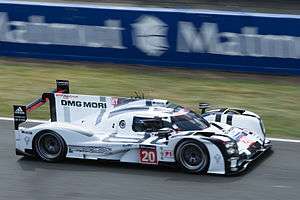
Most F1 drivers retire in their mid to late 30s; however, many keep racing in disciplines which are less physically demanding. The German touring car championship, the DTM, is a popular category involving ex-drivers such as two-time champion Mika Häkkinen and F1 race winners Jean Alesi, David Coulthard and Ralf Schumacher. In recent years, it has become common for former drivers who have had shorter careers to take up factory seats driving LMP1 cars in the FIA World Endurance Championship, with notable drivers including Mark Webber, Allan McNish, Anthony Davidson, Alexander Wurz, Kazuki Nakajima, and Sébastien Buemi. Some F1 drivers have left to race in the United States—Nigel Mansell and Emerson Fittipaldi duelled for the 1993 CART title, Rubens Barrichello moved to IndyCar in 2012, while Jacques Villeneuve, Juan Pablo Montoya, Nelson Piquet, Jr. and Scott Speed moved to NASCAR. Many drivers entered Formula E such as Nelson Piquet Jr, Sebastien Buemi, Bruno Senna, Jaime Alguersuari, Nick Heidfeld, Jarno Trulli, Jean-Eric Vergne and more. Some drivers, such as Vitantonio Liuzzi, Narain Karthikeyan and Jos Verstappen went on to race in the A1 Grand Prix series. During its existence from 2008 to 2011, Superleague Formula attracted ex-Formula One drivers like Sébastien Bourdais, Antônio Pizzonia and Giorgio Pantano. A series for former Formula One drivers, called Grand Prix Masters, ran briefly in 2005 and 2006.[79] Others, like Jackie Stewart, Gerhard Berger and Alain Prost, returned to F1 as team owners while their former competitors have become colour commentators for TV coverage such as James Hunt (BBC), Martin Brundle (BBC, ITV and Sky), David Hobbs (NBC), Alan Jones (BBC, Nine Network and Ten Network) David Coulthard (BBC and Channel 4), Luciano Burti for Globo (Brazil), and Jean Alesi for Italian national network RAI. Others, such as Damon Hill and Jackie Stewart, take active roles in running motorsport in their own countries. Carlos Reutemann became a politician and served as governor of his native state in Argentina.
Grands Prix
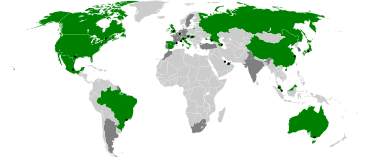
The number of Grands Prix held in a season has varied over the years. The inaugural 1950 world championship season comprised only seven races, while the 2016 season contained twenty-one races. Although throughout the first decades of the world championship there were no more than eleven Grands Prix a season, a large number of non-championship Formula One events also took place. The number of Grands Prix increased to an average of sixteen/seventeen by the late 1970s; simultaneously non-championship events ended by 1983. More Grands Prix began to be held in the 2000s, and recent seasons have seen an average of 19 races. In 2016 the calendar peaked at twenty-one events, the highest number of world championship races in one season.
Six of the original seven races took place in Europe; the only non-European race that counted towards the World Championship in 1950 was the Indianapolis 500, which was held to different regulations and later replaced by the United States Grand Prix. The F1 championship gradually expanded to other non-European countries. Argentina hosted the first South American Grand Prix in 1953, and Morocco hosted the first African World Championship race in 1958. Asia (Japan in 1976) and Oceania (Australia in 1985) followed, and the first race in the Middle East was held in 2004. The nineteen races of the 2014 Formula One season were spread over every populated continent except for Africa, with ten Grands Prix held outside Europe.
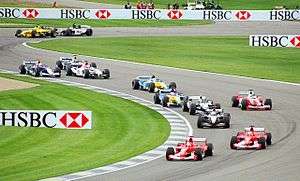
Some of the Grands Prix, such as the oldest recognised event the French Grand Prix, pre-date the formation of the World Championship and were incorporated into the championship as Formula One races in 1950. The British and Italian Grands Prix are the only events to have been held every Formula One season; other long-running races include the Belgian, German and currently defunct French Grands Prix. The Monaco Grand Prix, first held in 1929 and run continuously since 1955, is widely considered to be one of the most important and prestigious automobile races in the world.[80]
Traditionally each nation has hosted a single Grand Prix, which carries the name of the country. If a single country hosts multiple Grands Prix in a year they receive different names. In European countries the second event has often been titled the European Grand Prix, or named after a neighbouring state without a race. The United States has held six separate Grands Prix, including the Indianapolis 500, with the additional events named after the host city. Grands Prix are not always held at the same circuit each year, and may switch locations due to the suitability of the track or the financial status of the race organisers. The German Grand Prix currently alternates between the Nürburgring and Hockenheimring circuits, and others such as the American and French races have switched venues throughout their history.
All Grands Prix have traditionally been run during the day, until the inaugural Singapore Grand Prix hosted the first Formula One night race,[81] which was followed in 2009 by the day–night Abu Dhabi Grand Prix and then the Bahrain Grand Prix which converted to a night race in 2014. Along with holding races at night, other Grands Prix in Asia have had their start times adjusted to benefit the European television audience.[82]
Recent additions to the calendar include the Singapore Grand Prix which, in September 2008, hosted the first night race ever held in Formula One, the Abu Dhabi Grand Prix, which hosted the first day-to-night race in November 2009, the Korean Grand Prix, first held in October 2010 and the Indian Grand Prix, first held in October 2011.[83] The United States Grand Prix held its first race in Austin, Texas at the new Circuit of the Americas in 2012.[84] The first F1 Russian Grand Prix was held in 2014 at the new Sochi circuit, that runs around a venue used for the 2014 Winter Olympics.[85]
Circuits
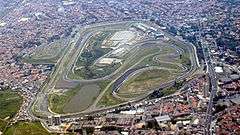

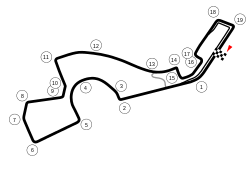
A typical circuit usually features a stretch of straight road on which the starting grid is situated. The pit lane, where the drivers stop for tyres, aerodynamic adjustments and minor repairs (such as changing the car's nose due to front wing damage) during the race, retirements from the race, and where the teams work on the cars before the race, is normally located next to the starting grid. The layout of the rest of the circuit varies widely, although in most cases the circuit runs in a clockwise direction. Those few circuits that run anticlockwise (and therefore have predominantly left-handed corners) can cause drivers neck problems due to the enormous lateral forces generated by F1 cars pulling their heads in the opposite direction to normal.
Most of the circuits currently in use are specially constructed for competition. The current street circuits are Monaco, Melbourne, Montreal, Singapore and Sochi, although races in other urban locations come and go (Las Vegas and Detroit, for example) and proposals for such races are often discussed—most recently New Jersey. Several circuits have been completely laid out on public roads in the past, such as Valencia in Spain, though Monaco is the only one that remains. The glamour and history of the Monaco race are the primary reasons why the circuit is still in use, even though it does not meet the strict safety requirements imposed on other tracks. Three-time World champion Nelson Piquet famously described racing in Monaco as "like riding a bicycle around your living room".[86]
Circuit design to protect the safety of drivers is becoming increasingly sophisticated, as exemplified by the new Bahrain International Circuit, added in 2004 and designed—like most of F1's new circuits—by Hermann Tilke. Several of the new circuits in F1, especially those designed by Tilke, have been criticised as lacking the "flow" of such classics as Spa-Francorchamps and Imola. His redesign of the Hockenheim circuit in Germany for example, while providing more capacity for grandstands and eliminating extremely long and dangerous straights, has been frowned upon by many who argue that part of the character of the Hockenheim circuits was the long and blinding straights into dark forest sections. These newer circuits, however, are generally agreed to meet the safety standards of modern Formula One better than the older ones.
Old favourites The RedBull Ring and the Autodromo Hermanos Rodriguez, returned to the calendar in 2014 and 2015 respectively.
The Circuit of Americas in Austin, the Sochi Autodrom in Sochi and the Baku City Circuit in Azerbaijan have all been introduced as brand new tracks since 2013.
A single race requires hotel rooms to accommodate at least 5000 visitors.[87]
Cars and technology
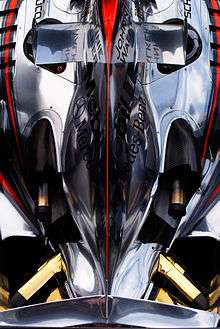
Modern Formula One cars are mid-engined open cockpit, open wheel single-seaters. The chassis is made largely of carbon-fibre composites, rendering it light but extremely stiff and strong. The whole car, including engine, fluids and driver, weighs only 691 kg (1,523 lb) – the minimum weight set by the regulations. If the construction of the car is lighter than the minimum, it can be ballasted up to add the necessary weight. The race teams take advantage of this by placing this ballast at the extreme bottom of the chassis, thereby locating the centre of gravity as low as possible in order to improve handling and weight transfer.[88]
The cornering speed of Formula One cars is largely determined by the aerodynamic downforce that they generate, which pushes the car down onto the track. This is provided by "wings" mounted at the front and rear of the vehicle, and by ground effect created by low air pressure under the flat bottom of the car. The aerodynamic design of the cars is very heavily constrained to limit performance and the current generation of cars sport a large number of small winglets, "barge boards", and turning vanes designed to closely control the flow of the air over, under, and around the car.
The other major factor controlling the cornering speed of the cars is the design of the tyres. From 1998 to 2008, the tyres in Formula One were not "slicks" (tyres with no tread pattern) as in most other circuit racing series. Instead, each tyre had four large circumferential grooves on its surface designed to limit the cornering speed of the cars.[89] Slick tyres returned to Formula One in the 2009 season. Suspension is double wishbone or multilink front and rear, with pushrod operated springs and dampers on the chassis – one exception being that of the 2009 specification Red Bull Racing car (RB5) which used pullrod suspension at the rear, the first car to do so since the Minardi PS01 in 2001. Ferrari used a pullrod suspension at both the front and rear in their 2012 car.[90] Both Ferrari (F138) and McLaren (MP4-28) of the 2013 season used a pullrod suspension at both the front and the rear.
Carbon-carbon disc brakes are used for reduced weight and increased frictional performance. These provide a very high level of braking performance and are usually the element which provokes the greatest reaction from drivers new to the formula.
Formula One cars must have four uncovered wheels, all made of the same metallic material, which must be one of two magnesium alloys specified by the FIA.[91] Magnesium alloy wheels made by forging are used to achieve maximum unsprung rotating weight reduction.[92]
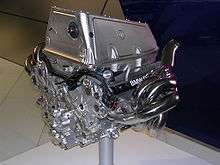
Starting with the 2014 Formula 1 season the engines have changed from a 2.4-litre naturally aspirated V8 to turbocharged 1.6 litre V6 "power-units".[93] These get a significant amount of their power from electric motors. In addition they include a lot of energy recovery technology. Engines run on unleaded fuel closely resembling publicly available petrol.[94] The oil which lubricates and protects the engine from overheating is very similar in viscosity to water. The 2006 generation of engines spun up to 20,000 RPM and produced up to 780 bhp (580 kW).[95] For 2007, engines were restricted to 19,000 rpm with limited development areas allowed, following the engine specification freeze from the end of 2006.[96] For the 2009 Formula One season the engines were further restricted to 18,000 rpm.[97]
A wide variety of technologies—including active suspension[98] and ground effect aerodynamics[99] —are banned under the current regulations. Despite this the current generation of cars can reach speeds in excess of 350 km/h (220 mph) at some circuits.[100] The highest straight line speed recorded during a Grand Prix was 372.6 km/h (231.5 mph), set by Juan Pablo Montoya during the 2005 Italian Grand Prix.[101] A Honda Formula One car, running with minimum downforce on a runway in the Mojave desert achieved a top speed of 415 km/h (258 mph) in 2006. According to Honda, the car fully met the FIA Formula One regulations.[102] Even with the limitations on aerodynamics, at 160 km/h (99 mph) aerodynamically generated downforce is equal to the weight of the car, and the oft-repeated claim that Formula One cars create enough downforce to "drive on the ceiling", while possible in principle, has never been put to the test. Downforce of 2.5 times the car's weight can be achieved at full speed. The downforce means that the cars can achieve a lateral force with a magnitude of up to 3.5 times that of the force of gravity (3.5g) in cornering.[103] Consequently, the driver's head is pulled sideways with a force equivalent to the weight of 20 kg in corners. Such high lateral forces are enough to make breathing difficult and the drivers need supreme concentration and fitness to maintain their focus for the one to two hours that it takes to complete the race. A high-performance road car like the Ferrari Enzo only achieves around 1g. [104]
As of 2015, each team may have no more than two cars available for use at any time.[105] Each driver may use no more than four engines during a championship season unless he drives for more than one team. If more engines are used, he drops ten places on the starting grid of the event at which an additional engine is used. The only exception is where the engine is provided by a manufacturer or supplier taking part in its first championship season, in which case up to five may be used by a driver.[106] Each driver may use no more than one gearbox for six consecutive events; every unscheduled gearbox change requires the driver to drop five places on the grid unless he failed to finish the previous race due to reasons beyond the team's control.[107]
Revenue and profits
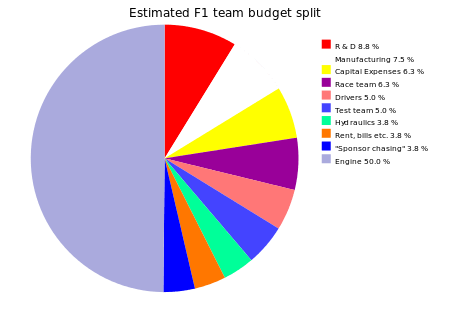
In March 2007, F1 Racing published its annual estimates of spending by Formula One teams.[108] The total spending of all eleven teams in 2006 was estimated at $2.9 billion US. This was broken down as follows: Toyota $418.5 million, Ferrari $406.5 m, McLaren $402 m, Honda $380.5 m, BMW Sauber $355 m, Renault $324 m, Red Bull $252 m, Williams $195.5 m, Midland F1/Spyker-MF1 $120 m, Toro Rosso $75 m, and Super Aguri $57 million.
Costs vary greatly from team to team. Honda, Toyota, McLaren-Mercedes, and Ferrari are estimated to have spent approximately $200 million on engines in 2006, Renault spent approximately $125 million and Cosworth's 2006 V8 was developed for $15 million.[109] In contrast to the 2006 season on which these figures are based, the 2007 sporting regulations ban all performance related engine development.[110]
Formula One teams pay entry fees of $500,000, plus $5,000 per point scored the previous year or $6,000 per point for the winner of the constructors' championship. Formula One drivers pay a Superlicense fee of $10,000 plus $1,000 per point.[111]
There have been controversies with the way profits are shared amongst the teams. The smaller teams have complained that the profits are unevenly shared favoring established top teams. In September 2015, Force India and Sauber officially lodged a complaint with the European Union against Formula One questioning the governance and stating that the system of dividing revenues and determining the rules is unfair and unlawful.[112]
The cost of building a brand new permanent circuit can be up to hundreds of millions of dollars, while the cost of converting a public road, such as Albert Park, into a temporary circuit is much less. Permanent circuits, however, can generate revenue all year round from leasing the track for private races and other races, such as MotoGP. The Shanghai International Circuit cost over $300 million[113] and the Istanbul Park circuit cost $150 million to build.[114]
A number of Formula One drivers earn the highest salary of any drivers in auto racing. The highest paid driver in 2010 was Fernando Alonso, who received $40 million in salary from Ferrari—a record for any driver.[115] The very top Formula One drivers get paid more than IndyCar or NASCAR drivers, however the earnings immediately fall off after the top three F1 drivers and the majority of NASCAR racers will make more money than their F1 counterparts.[116] Most top IndyCar drivers are paid around a tenth of their Formula One counterparts.[115]
Future
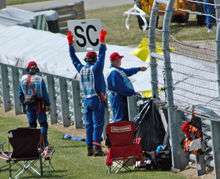
The expense of Formula One has seen the FIA and the Formula One Commission attempt to create new regulations to lower the costs for a team to compete in the sport.[117][118] Cost-saving proposals have included allowing customer cars, either by teams purchasing a car from another constructor, or the series supplying a basic chassis and engine to some teams at a low cost.[119][120] Allowing teams to share more car components such as the monocoque and safety components is also under consideration.[121] The FIA also continually researches new ways to increase safety in the sport, which includes introducing new regulations and accident procedures.
In the interest of making the sport truer to its role as a World Championship, Bernie Ecclestone has initiated and organised a number of Grands Prix in new countries. Proposals to hold future races are regularly made by both new locations and countries and circuits that have previously hosted a Formula One Grand Prix. One new race has been introduced in 2016, the Baku European Grand Prix in Azerbaijan.[122]
An enhanced rule package for 2017 is currently being considered by Formula One.[123] The introduction of 1000 bhp engines, achieved by reducing limitations on the current 1.6L turbocharged V6 power units,[124] is currently planned in order to increase the difficulty of driving a Formula One car.[118] Increasing the width of the cars to 2000mm, which was last seen in 1997, is another proposal set to be introduced.[118] A tender for a new tyre supplier contract, currently held by Pirelli, will be held before the 2017 season.[123] The new contract may see the introduction of lower profile tyres, with the wheel size potentially increasing from 13-inch to 18 or 21 inches.[118]
Media coverage
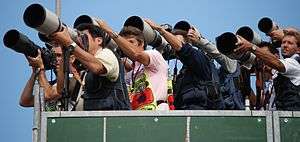
Formula One can be seen live or tape delayed in almost every country and territory around the world and attracts one of the largest global television audiences. The 2008 season attracted a global audience of 600 million people per race.[125] It is a massive television event; the cumulative television audience was calculated to be 54 billion for the 2001 season, broadcast to 200 territories.[126]
During the early 2000s, Formula One Group created a number of trademarks, an official logo, and an official website for the sport in an attempt to give it a corporate identity. Ecclestone experimented with a digital television package (known colloquially as Bernievision) which was launched at the 1996 German Grand Prix in cooperation with German digital television service "DF1", 30 years after the first GP colour TV broadcast, the 1967 German Grand Prix. This service offered the viewer several simultaneous feeds (such as super signal, on board, top of field, backfield, highlights, pit lane, timing) which were produced with cameras, technical equipment and staff different from those used for the conventional coverage. It was introduced in many countries over the years, but was shut down after the 2002 season for financial reasons.
TV stations all take what is known as the "World Feed", either produced by the FOM (Formula One Management) or occasionally, the "host broadcaster". The only station that originally differed from this was "Premiere"—a German channel which offers all sessions live and interactive, with features such as the onboard channel. This service was more widely available around Europe until the end of 2002, when the cost of a whole different feed for the digital interactive services was thought too much. This was in large part because of the failure of the "F1 Digital +" Channel launched through Sky in the United Kingdom. Prices were too high for viewers, considering they could watch both the qualifying and the races themselves free on ITV.
However, upon the commencement of its coverage for the 2009 season, the BBC reintroduced complementary features such as the "red button" in-car camera angles, multiple soundtracks (broadcast commentary, CBBC commentary for children, or ambient sound only) and a rolling highlights package. Different combinations of these features are available across the various digital platforms (Freeview, Freesat, Sky, Virgin Media cable and the BBC F1 web site) prior to, during, and after the race weekend. Not all services are available across all the various platforms due to technical constraints. The BBC also broadcasts a post-race programme called "F1 Forum" on the digital terrestrial platforms' "red button" interactive services.
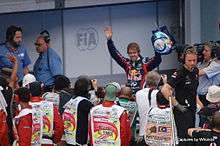
An announcement made on 12 January 2011, on the official Formula 1 website, announced that F1 would adopt the HD format for the 2011 season offering a world feed at a data rate of 42 Megabits/second (MPEG-2).[127] The BBC subsequently announced later that day that their 2011 F1 coverage would be broadcast in HD[128] which has been made immediately possible due to SIS LIVE, the provider of the BBC's F1 outside broadcast coverage, having already upgraded their technical facilities to HD as of the 2010 Belgian Grand Prix.[129]
It was announced on 29 July 2011 that Sky Sports and the BBC would team up to show the races in F1 in 2012. In March 2012, Sky launched a channel dedicated to F1, with an HD counterpart. Sky Sports F1 covered all races live without commercial interruption as well as live practice and qualifying sessions, along with F1 programming, including interviews, archive action and magazine shows.[130] The deal secured Formula 1 on Sky up to 2018.[131] The BBC in 2012 featured live coverage of half of the races in the season: China, Spain, Monaco, Europe, Britain, Belgium, Singapore, Korea, Abu Dhabi, and Brazil.[132] The BBC also showed live coverage of practice and qualifying sessions from those races.[133] For the races that the BBC did not show live, "extended highlights" of the race were available a few hours after the live broadcast.[134]
BBC ended their joint television contract after the 2015 season, transferring their rights to Channel 4 until the end of 2018 season.[135] Sky Sports F1 coverage will remain unaffected and BBC Radio 5 Live and 5 Live Sports Extra will be extended until the 2021 season.[136]
Formula One has an extensive web following, with most major TV companies covering it such as the BBC. The official Formula One website (formula1.com) has a live timing Java applet that can be used during the race to keep up with the leaderboard in real time. Recently an official application has been made available in the iTunes App Store that allows iPhone / iPod Touch users to see a real time feed of driver positions,[137] timing and commentary. The same official application has been available for Android phones and tablets since 2011.[138]
To accommodate fans who were unable to view the races on live television, Formula One Management's in-house production team began producing exclusive race edits synchronized to music from some of the world's top artists.[139]
Distinction between Formula One and World Championship races
Currently the terms "Formula One race" and "World Championship race" are effectively synonymous; since 1984, every Formula One race has counted towards the World Championship, and every World Championship race has been to Formula One regulations. But the two terms are not interchangeable.
- The first Formula One race was held in 1947,[140] whereas the World Championship did not start until 1950.[140]
- In the 1950s and 1960s there were many Formula One races that did not count for the World Championship[141] (e.g., in 1950, a total of twenty-two Formula One races were held, of which only six counted towards the World Championship).[140] The number of non-championship Formula One events decreased throughout the 1970s and 1980s, to the point where the last non-championship Formula One race was the 1983 Race of Champions.[141]
- The World Championship was not always exclusively composed of Formula One events:
- The World Championship was originally established as the "World Championship for Drivers", i.e., without the term "Formula One" in the title. It only officially became the Formula One World Championship in 1981.
- From 1950 to 1960, the Indianapolis 500 counted towards the World Championship.[141] This race was run to AAA/USAC regulations, rather than to Formula One regulations. Only one of the World Championship regulars, Alberto Ascari in 1952, started at Indianapolis during this period.[142]
- From 1952 to 1953, all races counting towards the World Championship (except the Indianapolis 500) were run to Formula Two regulations.[141] Formula One was not "changed to Formula Two" during this period; the Formula One regulations remained the same, and numerous non-Championship Formula One races were staged during this time.[143][144]
The distinction is most relevant when considering career summaries and "all time lists". For example, in the List of Formula One drivers, Clemente Biondetti is shown with 1 race against his name. Biondetti actually competed in four Formula One races in 1950,[145] but only one of these counted for the World Championship. Similarly, several Indianapolis 500 winners technically won their first World Championship race, though most record books choose to ignore this and instead only record regular participants.
See also
References
- ↑ The formula was defined during 1946; the first Formula One race was during 1947; the first World Championship season was 1950.
- ↑ "Discovering What Makes Formula One, Formula One — For Dummies". Dummies.com. Retrieved 14 September 2009.
- 1 2 "International Sporting Code" (PDF). FIA. 28 March 2007. Archived from the original (PDF) on 6 August 2009. Retrieved 30 August 2009.
- ↑ "Formula One suffers global drop in TV figures... and five per cent of fans turn off in Britain despite Lewis Hamilton's title win". Daily Mail. 1 February 2015. Retrieved 2 February 2015.
- ↑ "Formula 1 Legal Notices". Formula One. Retrieved 16 February 2010.
- ↑ Tovey, Alan (1 November 2014). "Formula One's vast costs are driving small teams to ruin". The Telegraph.
- ↑ Pfanner, Eric. "Liberty Media Agrees to Acquire Formula One for $4.4 Billion". Bloomberg.com. Bloomberg Media. Retrieved 8 September 2016.
- 1 2 3 4 "The last of the non-championship races". forix.com. Archived from the original on 27 February 2007. Retrieved 17 November 2007.
- ↑ Lawton, James (28 August 2007). "Moss can guide Hamilton through chicane of celebrity". The Independent. Newspaper Publishing.
- ↑ Henry, Alan (12 March 2007). "Hamilton's chance to hit the grid running". The Guardian. London. Retrieved 30 October 2007.
- ↑ "Decade seasons 1950–1959". Autocourse. Archived from the original on 7 August 2007. Retrieved 17 November 2007.
- ↑ Tuckey, Bill (28 January 1994). "Moss returns to scene of GP victory". The Age. Australia Company.
the all-conquering Mercedes-Benz cars... When the Germans withdrew from racing after the Le Mans 24-hour tragedy
- ↑ "Ferguson P99". gpracing.net. Archived from the original on 30 March 2008. Retrieved 17 November 2007.
- ↑ Bartunek, Robert-Jan (18 September 2007). "Sponsorship, the big business behind F1". CNN. Retrieved 8 November 2007.
- ↑ The 72 would come to be called the John Player Special, or JPS, Lotus, after the team's sponsor.
- ↑ Staniforth, Allan (1994). Competition Car Suspension. Haynes. p. 96. ISBN 0-85429-956-4.
- 1 2 3 Williams, Richard (28 March 1997). "The Formula for Striking It Rich". The Guardian. Guardian Newspapers.
- 1 2 "Face value: Mr Formula". The Economist. Economist Newspapers. 5 March 1997. p. 72.
- ↑ Blunsden, John (20 December 1986). "Filling Balestre's shoes is no job for a back-seat driver". Financial Times.
- ↑ Roebuck, Nigel "Power struggles and techno wars" Sunday Times 7 March 1993
- ↑ The Racing Analyst (2013-09-12). "The FISA-FOCA War | Allinsport". Allinsport.ch. Retrieved 2015-10-13.
- ↑ Hamilton, Maurice (8 March 1998). "Pros and cons of being just Williams; A quiet achiever keeps his head down as the new season gets under way with familiar high anxiety and a squealing over brakes". The Observer. Guardian Newspapers.
- ↑ Bamsey, Ian; Benzing, Enrico; Stanniforth, Allan; Lawrence, Mike (1988). The 1000 BHP Grand Prix cars. Guild Publishing. pp. 8–9. ISBN 0-85429-617-4. BMW's performance at the Italian GP is the highest qualifying figure given in Bamsey. The figure is from Heini Mader, who maintained the engines for the Benetton team, though maximum power figures from this period were necessarily estimates; BMW's dynamometer, for example, was only capable of measuring up to 1,100 bhp (820 kW). Figures higher than this are estimated from engine plenum pressure readings. Power in race trim at that time was lower than for qualifying due to the need for greater reliability and fuel efficiency during the race.
- ↑ "The technology behind Formula One racing cars". The Press. The Christchurch Press Company. 26 December 2005.
rivalling the 1200hp turbocharged monsters that eventually had to be banned in 1989
- ↑ Baldwin, Alan (17 February 2001). "F1 Plans Return of Traction Control". The Independent. Newspaper Publishing.
- ↑ "Who owns what in F1 these days?". Grandprix.com. Archived from the original on 12 March 2007. Retrieved 17 November 2007.
- 1 2 "F1's pressing safety question". BBC News. 5 March 2001. Retrieved 26 December 2007.
- ↑ "Jordan: Privateer era is over". ITV-F1.com. 24 August 2006. Archived from the original on 29 September 2007.
- ↑ "Schumacher makes history". BBC Sport. 21 July 2002. Retrieved 12 September 2006.
- ↑ "FIA Rules & Regulations Sporting Regulations: 2006 season changes". Formula One. Archived from the original on 9 November 2006. Retrieved 11 May 2006.
- ↑ "The last of the non-championship races". FORIX. Archived from the original on 17 October 2006. Retrieved 17 November 2007.
- ↑ This is not the same team as the 1954–94 nor 2010–11 iterations.
- ↑ "Everything to play for – 2015 Season Preview". Formula1.com. Retrieved 6 March 2015.
- 1 2 "£40 million budget cap and 13 teams for 2010". Formula 1. 30 April 2009. Retrieved 21 March 2010.
- ↑ "Mosley offers compromise on 2010". BBC News. 18 June 2009. Retrieved 21 March 2010.
- 1 2 Briggs, Gemma (19 June 2009). "How the formula one crisis evolved". The Guardian. UK. Retrieved 23 June 2009.
- ↑ "F1 deal ends threat of breakaway". BBC News. 24 June 2009. Retrieved 25 June 2009.
- ↑ "Mosley warning over F1 peace deal". BBC News. 26 June 2009. Retrieved 21 March 2010.
- ↑ "Max Mosley makes dramatic U-turn over his future as FIA president", The Daily Telegraph, 26 June 2009
- ↑ "Press release". Formula One Teams Association (FOTA). 8 July 2009. Retrieved 8 July 2009.
- ↑ "Press Release". FIA. 8 July 2009. Archived from the original on 10 July 2009. Retrieved 8 July 2009.
- ↑ Beer, Matt; Autosport (1 August 2009). "New Concorde Agreement finally signed". Retrieved 1 August 2009.
- 1 2 "A timeline of Formula One". ESPN F1. Retrieved 20 February 2011.
- ↑ "Desiré Wilson". f1rejects.com. Archived from the original on 5 June 2007. Retrieved 17 November 2007.
- ↑ "Practice and qualifying". Formula One. Retrieved 21 October 2009.
- 1 2 3 "Driver changes and additional drivers". Formula One World Championship. 10 June 2011. Retrieved 10 June 2011.
- 1 2 "Sporting regulations: Practice and qualifying". Formula1.com. Formula One World Championship. Retrieved 3 January 2016.
- ↑ "New 2016 tyre regulations for formula one". Pirelli.com. Pirelli. Retrieved 12 July 2016.
- ↑ "Sporting regulations: Tyres". Formula1.com. Formula One World Championship. Retrieved 18 January 2015.
- ↑ "F1 race starting regulations". Formula One. Retrieved 16 October 2010.
- ↑ "Flags". Formula One. 21 June 2003. Retrieved 3 July 2008.
- ↑ "New safety car driver announced". GPUpdate.net. 8 March 2000. Retrieved 30 January 2011.
- ↑ "Race distance". Formula1.com. Retrieved 4 January 2015.
- ↑ "FButton scores tenth win in longest ever race". F1 Fanatic. 13 June 2011. Retrieved 4 January 2015.
- ↑ "Sporting regulations: Points". Formula1.com. Formula One World Championship. Retrieved 12 January 2015.
- ↑ "Sporting regulations: Classification". Formula1.com. Formula One World Championship. Retrieved 12 January 2015.
- ↑ Baldwin, Alan (5 April 2009). "Button wins Malaysian GP cut short by rain". Thomas Reuters Corporate. Reuters. Retrieved 25 May 2009.
- ↑ Diepraam, Mattijs (21 November 2007). "Poachers turned gamekeepers: how the FOCA became the new FIA Part 1: Introduction and timeline". 8W. FORIX/autosport.com. Retrieved 16 October 2010.
- ↑ "Cosworth return unlikely says Stewart". F1-Live.com. Archived from the original on 31 March 2008. Retrieved 1 February 2012.
- ↑ Cooper, Adam. "Mosley Stands Firm on Engine Freeze". Speed TV. Archived from the original on 5 November 2007. Retrieved 1 February 2012.
- ↑ "First own-design for Toro Rosso". GPUpdate.net. 1 February 2010. Retrieved 10 January 2015.
Being recognised as a Constructor involves owning the intellectual property rights to what are defined as the listed parts: these are effectively the monocoque, the safety structures that are subject to homologation and crash testing, which means the rear and front structures, primary and secondary roll-over structures and the complete aerodynamic package, the suspension, fuel and cooling systems.
- ↑ "Formula 1: Interview — Toro Rosso's Gerhard Berger". Formula 1. 23 May 2008. Retrieved 23 May 2008.
- ↑ "McLaren is F1's biggest spender". F1i. 16 June 2006. Archived from the original on 9 February 2008. Retrieved 7 January 2007.
- ↑ Saward, Joe (20 September 2010). "Jérôme d'Ambrosio and Virgin‽". Joe Saward's Grand Prix Blog. Retrieved 11 June 2011.
- ↑ "Klien signed as HRT Friday driver". Grandprix.com. 6 May 2010. Retrieved 10 June 2011.
- 1 2 "APPENDIX L TO THE INTERNATIONAL SPORTING CODE" (PDF). Fédération Internationale de l'Automobile. 7 April 2011. Retrieved 10 June 2011.
- ↑ Allen, James (11 October 2010). "Inside an F1 team's driving simulator". James Allen on F1. Retrieved 10 June 2011.
- ↑ "Taking the lag out of dynamics simulation". SAE Automotive Engineering Magazine. Retrieved 31 August 2015.
- ↑ "Ferrari Changed His Simulator Software". F1 Simulator Maniac. Retrieved 31 August 2015.
- ↑ Offermans, Marcel. "rFactor: Full Steam Ahead!". Planet Marrs. Retrieved 31 August 2015.
- ↑ "History of the Image Space Inc. Software Engine". Image Space Incorporated. Retrieved 31 August 2015.
- ↑ "Number 17 to be retired in Bianchi's honour". Formula1.com. 20 July 2015. Retrieved 31 August 2015.
- ↑ Benson, Andrew (11 January 2014). "Formula 1's governing body confirm drivers' numbers". BBC Sport. Retrieved 21 March 2014.
- 1 2 Fearnly, Paul (5 December 2013). "F1′s number conundrum". MotorSport Magazine. Retrieved 21 March 2014.
- ↑ Collantine, Keith (7 January 2008). "Your questions: F1 and the number 13". F1Fanatic.co.uk. Retrieved 10 June 2011.
- ↑ Collantine, Keith. "Your questions: F1 car numbers". F1Fanatic.co.uk. Retrieved 10 May 2011.
- ↑ Jack Brabham, F1 champion in 1959, 1960 and 1966, won the French Formula Two championship in 1966, but there was no international F2 championship that year.
- ↑ "Five F1 champions who wouldn't have made their debuts". crash.net. Crash Media Group. 8 January 2015. Retrieved 12 October 2015.
- ↑ "Masters series officially wound up". Autosport. 29 November 2007. Retrieved 4 July 2008.
- ↑ "His Serene Highness Prince Rainier of Monte Carlo awarded the first FIA Gold Medal for Motor Sport.". Fédération Internationale de l'Automobile. 14 October 2004. Archived from the original on 15 November 2007. Retrieved 23 April 2014.
- ↑ "Singapore confirms 2008 night race". Formula1.com. Formula One Administration. 11 May 2007. Retrieved 30 August 2009.
- ↑ "Malaysia start time under review". BBC Sport. British Broadcasting Corporation. 6 April 2009. Retrieved 25 April 2014.
- ↑ May, Andy (22 January 2009). "India 'will host 2011 Grand Prix'". BBC News/. Retrieved 8 January 2010.
- ↑ "Formula One returns to the United States". formula1.com/. 25 May 2010. Retrieved 25 May 2010.
- ↑ "Sochi Grand Prix: F1 comes to Russia in 2014". Russia Today. 14 October 2010. Retrieved 11 May 2010.
- ↑ "Monaco challenge remains unique – Formula 1". Motor Sport Magazine. 2011-05-24. Retrieved 2013-10-12.
- ↑ "Sport : F-1 race at Sohna or Greater Noida". The Hindu. Chennai, India. 18 September 2007. Retrieved 16 October 2010.
- ↑ "A racing revolution? Understanding 2014's technical regulations". Formula1.com. 2014-01-24. Retrieved 2014-03-17.
- ↑ "Tyres". Formula One. Retrieved 4 July 2008.
- ↑ "2012 Ferrari – pre-launch overview". Formula One World Championship Ltd. Retrieved 2 February 2012.
- ↑ https://www.formula1.com/en/championship/inside-f1/rules-regs/tyres-and-wheels.html
- ↑ http://www.f1wheels.com
- ↑ "2013 engine changes approved, but postponement possible". Formula 1. Retrieved 16 December 2012.
- ↑ "FIA Sporting Regulations — Fuel". Formula 1. Retrieved 23 May 2008.
- ↑ Renault F1 engine listing . Retrieved 1 June 2007.
- ↑ "FIA Sporting Regulations — Engine". Formula 1. Retrieved 23 May 2008.
- ↑ "FIA Formula One World Championship – 2009 Technical Regulations" (PDF). FIA. Retrieved 4 April 2009.
- ↑ "F1 regulations: Suspension and steering systems". Retrieved 9 August 2015.
- ↑ "F1 regulations: Bodywork, dimensions, and cockpit". Retrieved 9 August 2015.
- ↑ Grand Prix of Italy www.fia.com. Retrieved 12 October 2006. Archived 9 June 2012 at the Wayback Machine.
- ↑ "Bonneville 400: Just for the Record". Retrieved 26 August 2015.
- ↑ "Bonneville 400". Racecar Engineering. 5 August 2008. Retrieved 30 August 2015.
- ↑ "Official F1 website Aerodynamics section". Formula One. Retrieved 30 August 2009.
- ↑ Ferrari Enzo www.fast-autos.net. Retrieved 15 March 2007.
- ↑ "F1 regulations: Spare Cars". Retrieved 9 August 2015.
- ↑ "F1 regulations: Power unit and ERS". Retrieved 9 August 2015.
- ↑ "F1 regulations: Gearboxes". Formula One. Retrieved 9 August 2015.
- ↑ "Budgets and Expenses in Formula1". F1scarlet. Retrieved 30 August 2015.
- ↑ "The real cost of F1" F1 Racing (March 2007) Haymarket Publishing
- ↑ "2007 FIA Regulations". McLaren. Archived from the original on 20 May 2007. Retrieved 23 May 2007.
- ↑ Sylt, Christian (October 28, 2013). "The Price of Power". Autoweek: 64–66.
- ↑ "F1 faces possible investigation from the European Union". guardian.uk. 29 September 2015.
- ↑ Benson, Andrew (27 September 2004). "High price takes shine off F1". BBC News. Retrieved 30 August 2009.
- ↑ "Pioneer Investors". Pioneer Investors. 7 February 2006. Retrieved 30 August 2009.
- 1 2 "Ferrari's forty-million dollar man". ESPN. Retrieved 7 October 2014
- ↑ http://www.autoblog.com/2012/11/16/red-bull-infographic-compares-and-contrasts-nascar-and-f1/
- ↑ Roberts, James; Noble, Jonathan (23 January 2015). "Small F1 teams hopeful of progress on cost cuts before season start". Autosport.com. Haymarket Media. Retrieved 8 March 2015.
- 1 2 3 4 Benson, Andrew (13 February 2015). "Mercedes & Red Bull split on changes to F1 cars for 2016". BBC Sport. BBC. Retrieved 8 March 2015.
- ↑ "Ecclestone still pushing customer teams plan". ESPN.co.uk. 8 March 2015. Retrieved 8 March 2015.
- ↑ Weaver, Paul (9 November 2014). "Force India and Sauber attack F1's move towards customer cars". TheGuardian.com. Guardian Media Group. Retrieved 8 March 2015.
- ↑ Rencken, Dieter; Noble, Jonathan (25 February 2015). "Formula 1's small teams push for 'core car' plan". Autosport.com. Haymarket Media. Retrieved 8 March 2015.
- ↑ Galloway, James. "F1 expansion continues with Azerbaijan to join the calendar in 2016". Retrieved 28 July 2014.
- 1 2 Noble, Jonathan (17 February 2015). "Formula 1 revamp must wait to 2017 as early revolution rejected". Autosport.com. Haymarket Media. Retrieved 8 March 2015.
- ↑ Noble, Jonathan (6 February 2015). "Formula 1's 1000bhp rules revamp moves closer". Autosport.com. Haymarket Media. Retrieved 8 March 2015.
- ↑ "Formula 1's Global TV Audience Expands". paddocktalk.com/Global Broadcast Report. Archived from the original on 23 November 2011. Retrieved 29 June 2009.
- ↑ BBC Sports, F1 viewing figures drop, 26 February 2002. Retrieved on 10 March 2007. The cumulative figure, which exceeds the total population of the planet by many times, counts all viewers who watch F1 on any programme at any time during the year.
- ↑ "Formula One Coverage goes HD for 2011". Formula1.com. 2011-01-12. Retrieved 2014-06-16.
- ↑ "New role for Eddie Jordan as BBC F1 coverage goes HD". BBC Sport. 12 January 2011. Retrieved 12 January 2011.
- ↑ "SIS LIVE upgrades OB coverage of Formula 1 for BBC Sport" (PDF). sislive.tv. Retrieved 12 January 2011.
- ↑ Mills, Adam (13 December 2011). "Q&A with Sky F1". Badger GP. Retrieved 21 December 2011.
- ↑ "Sky Sports Pack – Live Football, F1, Cricket, Rugby & More Sports". F1.sky.com. Retrieved 2013-10-12.
- ↑ "BBC reveals F1 coverage schedule for 2012". BBC. 25 November 2011. Retrieved 25 November 2011.
- ↑ "BBC and Sky awarded rights in new Formula 1 deal". BBC. 29 July 2011. Retrieved 30 July 2011.
- ↑ "New details of co-operation between Sky and BBC emerge". James Allen on F1. 29 July 2011. Retrieved 30 July 2011.
- ↑ "Channel 4 becomes terrestrial home of Formula 1". Channel 4. 21 December 2015. Retrieved 23 December 2015.
- ↑ "BBC to end f1 TV". BBC to end Formula 1 television contract early. BBC. Retrieved 21 December 2015.
- ↑ "iTunes Store". Itunes.apple.com. Retrieved 19 June 2009.
- ↑ "Google Play Store". play.google.com. Archived from the original on 10 November 2013. Retrieved 11 January 2014.
- ↑ Official Formula One Website, Fédération Internationale de l'Automobile, 2013
- 1 2 3 "Timeline of Formula One". ESPN. Retrieved 29 May 2016.
- 1 2 3 4 "The Formula One Archives". www.silhouet.com. Retrieved 29 May 2016.
- ↑ "Alberto Ascari". www.historicracing.com. Retrieved 29 May 2016.
- ↑ "1952 Non-World Championship Grands Prix". www.silhouet.com. Retrieved 29 May 2016.
- ↑ "1953 Non-World Championship Grands Prix". www.silhouet.com. Retrieved 29 May 2016.
- ↑ "Clemente Biondetti Formula One race entries". ChicaneF1. Retrieved 29 May 2016.
Further reading
- Arron, Simon & Hughes, Mark (2003). The Complete Book of Formula One. Motorbooks International. ISBN 0-7603-1688-0.
- Gross, Nigel et al. (1999). "Grand Prix Motor Racing". In, 100 Years of Change: Speed and Power (pp. 55–84). Parragon.
- Hayhoe, David & Holland, David (2006). Grand Prix Data Book (4th edition). Haynes, Sparkford, UK. ISBN 1-84425-223-X.
- Higham, Peter (2003). The international motor racing guide. David Bull, Phoenix, AZ, USA. ISBN 1-893618-20-X.
- "Inside F1". (2011). The Official Formula 1 Website. Retrieved 11 November 2011.
- Jones, Bruce (1997). The Ultimate Encyclopedia of Formula One. Hodder & Stoughton.
- Jones, Bruce (1998). Formula One: The Complete Stats and Records of Grand Prix Racing. Parragon.
- Jones, Bruce (2003). The Official ITV Sport Guide: Formula One Grand Prix 2003. Carlton. Includes foreword by Martin Brundle. ISBN 1-84222-813-7.
- Jones, Bruce (2005). The Guide to 2005 FIA Formula One World Championship: The World's Bestselling Grand Prix Guide. Carlton. ISBN 1-84442-508-8.
- Lang, Mike (1981–1992). Grand Prix! volumes 1–4. Haynes, Sparkford, UK.
- Menard, Pierre (2006). The Great Encyclopedia of Formula 1, 5th edition. Chronosport, Switzerland. ISBN 2-84707-051-6
- Miltner, Harry (2007). Race Travel Guide 2007. egoth: Vienna, Austria. ISBN 978-3-902480-34-7
- Small, Steve (2000). Grand Prix Who's Who (3rd edition). Travel Publishing, UK. ISBN 1-902007-46-8.
- Tremayne, David & Hughes, Mark (1999). The Concise Encyclopedia of Formula One. Parragon
- Twite, Mike. "Formula Regulations: Categories for International Racing" in Northey, Tom, ed. The World Of Automobiles, Volume 6, pp. 701–3. London: Phoebus, 1978.
External links
- Official website (English) (French) (Spanish)
- Official FIA website
- "Grand Prix racing". Encyclopedia Britannica Online.
- Formula One – championship summary at DriverDB.com
- History of Grand Prix Motor Racing
